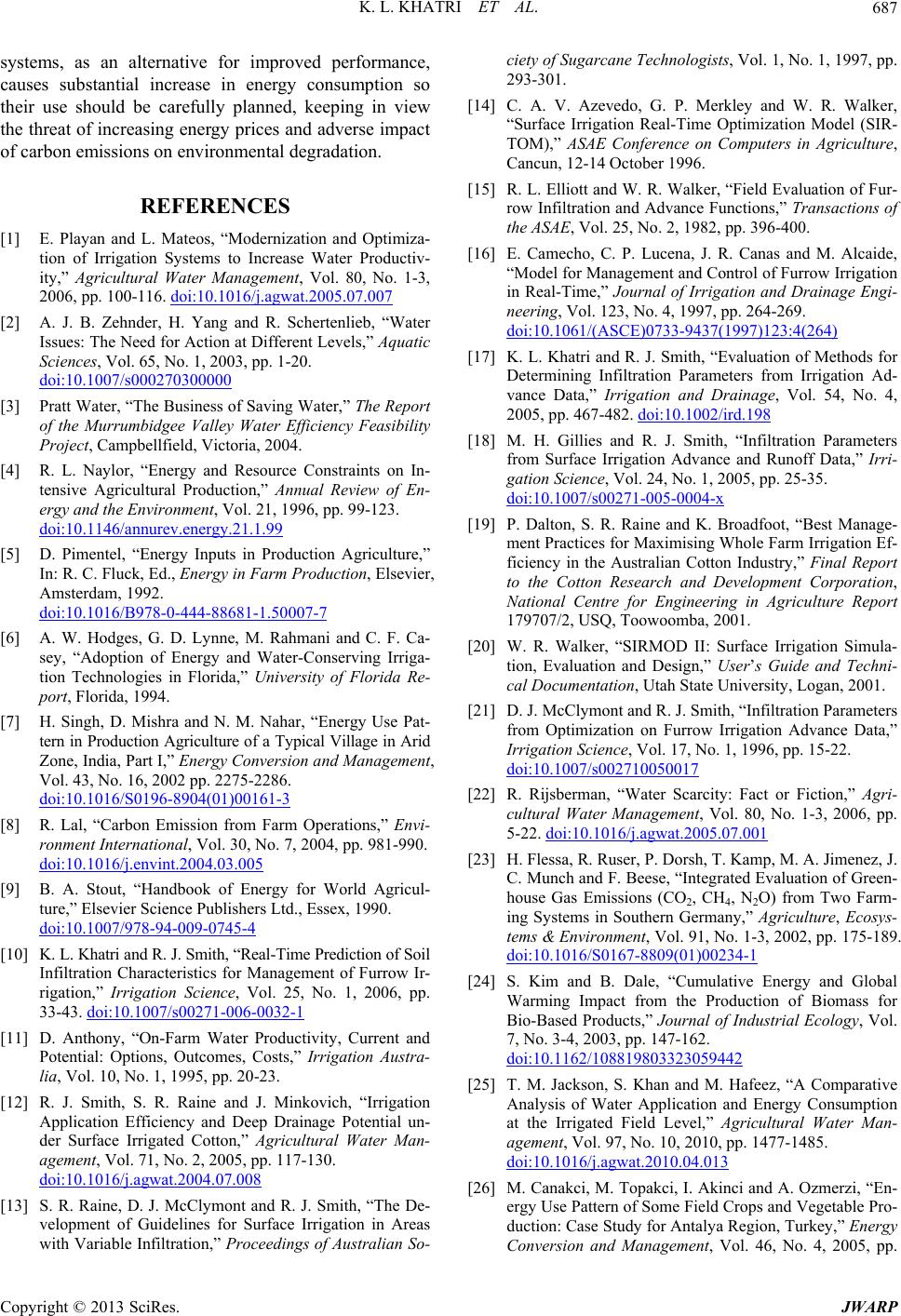
K. L. KHATRI ET AL. 687
systems, as an alternative for improved performance,
causes substantial increase in energy consumption so
their use should be carefully planned, keeping in view
the threat of increasing energy prices and adverse impact
of carbon emissions on environmental degradation.
REFERENCES
[1] E. Playan and L. Mateos, “Modernization and Optimiza-
tion of Irrigation Systems to Increase Water Productiv-
ity,” Agricultural Water Management, Vol. 80, No. 1-3,
2006, pp. 100-116. doi:10.1016/j.agwat.2005.07.007
[2] A. J. B. Zehnder, H. Yang and R. Schertenlieb, “Water
Issues: The Need for Acti on at Different Levels,” Aquatic
Sciences, Vol. 65, No. 1, 2003, pp. 1-20.
doi:10.1007/s000270300000
[3] Pratt Water, “T he Business of Saving Water,” The Report
of the Murrumbidgee Valley Water Efficiency Feasibility
Project, Campbellfield, Victoria, 2004.
[4] R. L. Naylor, “Energy and Resource Constraints on In-
tensive Agricultural Production,” Annual Review of En-
ergy and the Environment, Vol. 21, 1996, pp. 99-123.
doi:10.1146/annurev.energy.21.1.99
[5] D. Pimentel, “Energy Inputs in Production Agriculture,”
In: R. C. Fluck, Ed., Energy in Farm Production, Elsevier,
Amsterdam, 1992.
doi:10.1016/B978-0-444-88681-1.50007-7
[6] A. W. Hodges, G. D. Lynne, M. Rahmani and C. F. Ca-
sey, “Adoption of Energy and Water-Conserving Irriga-
tion Technologies in Florida,” University of Florida Re-
port, Florida, 1994.
[7] H. Singh, D. Mishra and N. M. Nahar, “Energy Use Pat-
tern in Production Agriculture of a Typical Village in Arid
Zone, India, Part I,” Energy Conversion and Management,
Vol. 43, No. 16, 2002 pp. 2275-2286.
doi:10.1016/S0196-8904(01)00161-3
[8] R. Lal, “Carbon Emission from Farm Operations,” Envi-
ronment International, Vol. 30, No. 7, 2004, pp. 981-990.
doi:10.1016/j.envint.2004.03.005
[9] B. A. Stout, “Handbook of Energy for World Agricul-
ture,” Elsevier Science Publishers Ltd., Essex, 1990.
doi:10.1007/978-94-009-0745-4
[10] K. L. Khatri and R. J. Smith, “Real-Time Prediction of Soil
Infiltration Characteristics for Management of Furrow Ir-
rigation,” Irrigation Science, Vol. 25, No. 1, 2006, pp.
33-43. doi:10.1007/s00271-006-0032-1
[11] D. Anthony, “On-Farm Water Productivity, Current and
Potential: Options, Outcomes, Costs,” Irrigation Austra-
lia, Vol. 10, No. 1, 1995, pp. 20-23.
[12] R. J. Smith, S. R. Raine and J. Minkovich, “Irrigation
Application Efficiency and Deep Drainage Potential un-
der Surface Irrigated Cotton,” Agricultural Water Man-
agement, Vol. 71, No. 2, 2005, pp. 117-130.
doi:10.1016/j.agwat.2004.07.008
[13] S. R. Raine, D. J. McClymont and R. J. Smith, “The De-
velopment of Guidelines for Surface Irrigation in Areas
with Variable Infiltration,” Proceedings of Australian So-
ciety of Sugarcane Technologists, Vol. 1, No. 1, 1997, pp.
293-301.
[14] C. A. V. Azevedo, G. P. Merkley and W. R. Walker,
“Surface Irrigation Real-Time Optimization Model (SIR-
TOM),” ASAE Conference on Computers in Agriculture,
Cancun, 12-14 October 1996.
[15] R. L. Elliott and W. R. Walker, “Field Evaluation of Fur-
row Infiltration and Advance Functions,” Transactions of
the ASAE, Vol. 25, No. 2, 1982, pp. 396-400.
[16] E. Camecho, C. P. Lucena, J. R. Canas and M. Alcaide,
“Model for Management and Control of Furrow Irrigation
in Real-Time,” Journal of Irrigation and Drainage Engi-
neering, Vol. 123, No. 4, 1997, pp. 264-269.
doi:10.1061/(ASCE)0733-9437(1997)123:4(264)
[17] K. L. Khatri and R. J. Smith, “Evaluation of Methods for
Determining Infiltration Parameters from Irrigation Ad-
vance Data,” Irrigation and Drainage, Vol. 54, No. 4,
2005, pp. 467-482. doi:10.1002/ird.198
[18] M. H. Gillies and R. J. Smith, “Infiltration Parameters
from Surface Irrigation Advance and Runoff Data,” Irri-
gation Science, Vol. 24, No. 1, 2005, pp. 25-35.
doi:10.1007/s00271-005-0004-x
[19] P. Dalton, S. R. Raine and K. Broadfoot, “Best Manage-
ment Practices for Maximising Whole Farm Irrigation Ef-
ficiency in the Australian Cotton Industry,” Final Report
to the Cotton Research and Development Corporation,
National Centre for Engineering in Agriculture Report
179707/2, USQ, Toowoomba, 2001.
[20] W. R. Walker, “SIRMOD II: Surface Irrigation Simula-
tion, Evaluation and Design,” User’s Guide and Techni-
cal Documentation, Utah State University, Logan, 2001.
[21] D. J. McClymont and R. J. Smith, “Infiltration Parameters
from Optimization on Furrow Irrigation Advance Data,”
Irrigation Science, Vol. 17, No. 1, 1996, pp. 15-22.
doi:10.1007/s002710050017
[22] R. Rijsberman, “Water Scarcity: Fact or Fiction,” Agri-
cultural Water Management, Vol. 80, No. 1-3, 2006, pp.
5-22. doi:10.1016/j.agwat.2005.07.001
[23] H. Flessa, R. Ruser, P. Dorsh, T. Kamp, M. A. Jimenez, J.
C. Munch and F. Beese, “Integrated Evaluation of Green-
house Gas Emissions (CO2, CH4, N2O) from Two Farm-
ing Systems in Southern Germany,” Agriculture, Ecosys-
tems & Environment, Vol. 91, No. 1-3, 2002, pp. 175-189.
doi:10.1016/S0167-8809(01)00234-1
[24] S. Kim and B. Dale, “Cumulative Energy and Global
Warming Impact from the Production of Biomass for
Bio-Based Products,” Journal of Industrial Ecology, Vol.
7, No. 3-4, 2003, pp. 147-162.
doi:10.1162/108819803323059442
[25] T. M. Jackson, S. Khan and M. Hafeez, “A Comparative
Analysis of Water Application and Energy Consumption
at the Irrigated Field Level,” Agricultural Water Man-
agement, Vol. 97, No. 10, 2010, pp. 1477-1485.
doi:10.1016/j.agwat.2010.04.013
[26] M. Canakci, M. Topakci, I. Akinci and A. Ozmerzi, “En-
ergy Use Pattern of Some Field Crops and Vegetable Pro-
duction: Case Study for Antalya Region, Turkey,” Energy
Conversion and Management, Vol. 46, No. 4, 2005, pp.
Copyright © 2013 SciRes. JWARP